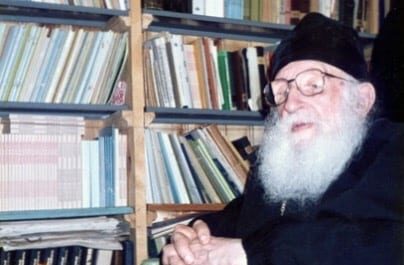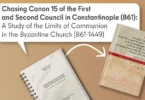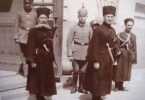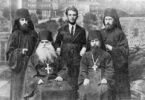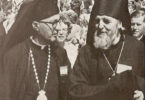This report delivered at an assembly of the ROCOR Western European Diocese in 1949 by a leading scholar of Canon Law of the Russian Church Abroad, Fr. George (later Bp. Gregory Grabbe, d. 1996), contains the basis for the ROCOR’s refusal to accept the claims of the Ecumenical Patriarch to authority over the whole Orthodox diaspora. Several of the points Fr. George raises must be contextualized. For example, his understanding of the word “ethnos” in Apostolic Canon 34 as having the modern sense of a nation or an ethnic group, is problematic. Furthermore, Canon 39 of the Council in Trullo is applicable to the situation of the Russian Church Abroad only insofar as it concerns aid provided to refugees, but it does not justify the existence worldwide of an ecclesiastical body founded on national and political principles. Fr. George’s talk is one part of a valuable postwar debate on what type of structure for the Russian refugee church would be most in line with Christian principles. It was in response to Fr. George’s talk that Fr. Alexander Schmemann wrote his article “A Polemic About the Church”.
The question of peace and unity has elicited some polemic. In responding to it now, I am not going to focus on various minor concerns relating to the structure of the Russian Church Abroad, but rather on one of the main arguments advanced by supporters of the existence of the Exarchate of the Patriarchate of Constantinople in Western Europe.
These stem from the assertion that, according to canonical norms, all churches in Western Europe ought to be subject to the Patriarch of Constantinople. From this point of view, the fact that other churches exist there that are not under his jurisdiction is a canonical anomaly. Therefore, as conceived by them, the establishment of ecclesiastical unity entails the abolition of the church structures subject to the Synod of Bishops [of the Church Abroad —trans.]. “Suppose Bishop Nathaniel is sincerely peace-loving”, we read in the semiofficial lead article in the November 1949 issue of Slovo Tserkvi, a publication approved by Metropolitan Vladimir [Tikhonitskii, Exarch of the Church of Constantinople —trans.]. “But how can he, as an Orthodox bishop, fail to understand that his very activities, which are parallel to those of our diocese, create an intolerable situation that is against all the canons and against common sense, in that it introduces divisions into the very body of the Church?”
Is such a statement correct? If, indeed, the Patriarch of Constantinople has exclusive canonical jurisdiction over Western Europe, then, of course, the matter would be simple in the extreme. In that case, all parishes in other jurisdictions would be made subject to the New Rome and the only thing left to resolve would be how this would be carried out in practical terms. The question of jurisdiction over Western Europe is intimately linked with the question of overall jurisdiction over the churches outside the geographical boundaries of the generally acknowledged Autocephalous Churches. One might pose it with regard to an even larger area: what determines the jurisdiction of the individual churches? Is it merely defined by their geographical borders, or does it extend to embrace the members and clergy of a particular church that live beyond these limits?
In order to resolve a question of canon law, one must take it in all its breath and depth. One must examine it not in formal and legal terms, but rather in terms of the basic principles of church life and praxis. For “ancient custom” has its own particular meaning; in it we can hear the voice of the consciousness of the church. In matters of jurisdictional dispute, the Holy Canons do know the principle of duration (Canon 17 of the Fourth Œcumenical Council), on the basis of which various borders and privileges of individual sees were established at one time or another.
We have no need to spend much time on the question of the significance of the geographical boundaries of any given jurisdiction. They are fixed by a series of ecclesiastical canons, which I will not bother to cite in light of their universal familiarity, just as I will not cite the canons that forbid bishops from encroaching on one another’s domains. At the same time, as Professor Sergei V. Troitskii rightly pointed out, “the fundamental basis for the organization of the church is personal, not territorial… Even when episcopal jurisdiction is restricted to a particular territory, this is done not on any particular canonical grounds, but merely for the sake of practical convenience, for reasons of oikonomia.” [1]“Dymnoe nadmenie mira i Tserkov’,” [‘The Gloomy Arrogance of this World’ and the Church”], Tserkovnyie vedomosti, Vol. 21-22, 1924, p. 7
It is true that a clergyman who is outside the geographical limits of his diocese remains under the authority and within the competence of his bishop. A tradition of many hundreds of years has established that metochia of one church may exist within the domain of another. The same Prof. Troitskii draws our attention to the fact that in the Ancient Church, there were many churches in domain of the Constantinopolitan Patriarchate that were under the Pope of Rome, and vice versa, that there were institutions and churches within the territory of the Roman Church that answered to the Patriarch of Constantinople [2]Ibid.. Such a practice was legitimized going forward by Canon 1 of the Council of Constantinople of 879. This canon reads as follows: “The Holy and Œcumenical Council has decreed that so far as concerns any clerics, or laymen, or bishops from Italy that are staying in Asia, or Europe, or Africa, under bond, or deposition, or anathema imposed by the most holy Pope John, all such persons are to be held in the same condition of penalization also by the most holy Patriarch of Constantinople, Photius; that is to say, either deposed, or anathematized, or excommunicated. All those persons, on the other hand, whom Photius our most holy Patriarch, has condemned or may condemn to excommunication, or deposition, or anathematization, in any diocese whatsoever, whether clerics or laymen or any of the persons who are of prelatical or priestly rank, are to be treated likewise by most holy Pope John, and the holy Church of God of the Romans with him, and be held in the same category of penalization…”
From this canon, it is evident that there were bishops, clergymen, and laypeople under the jurisdiction of the Bishop of Rome within the territory of the Patriarchate of Constantinople (it is mentioned in Canon 28 of the Fourth Œcumenical Council that Asia falls under its remit). The threefold construction almost seems to suggest that there existed the entire extra-territorial dioceses. With respect to these, the Canon requires any canonical decision of the Bishop of Rome to be recognized by the Patriarch of Constantinople, just as the latter’s decisions ought to be recognized by the Pope of Rome with respect to Greek bishops, clergymen, and laity in the territories under his control, in any domain whatsoever. This Canon does not annul the territorial partitioning of the Church but rather supplements the principle of territorial jurisdiction by making it a principle of ethnic jurisdiction, of jurisdiction over a people who belong to a particular Local Church, irrespective of where they are located. In light of this rule, that there should be metochia of one Church on the territory of another is not an anomaly, but a normal, canonical phenomenon.
Having as its aim the salvation of its members, the Church is not restricted in its structure to one and only one principle, be it territorial or ethnic. When the Canons of the Church discuss the boundaries of various Churches, the territorial principle usually prevails, for in Antiquity, when travel was more difficult and the members of individual churches more rarely emigrated to foreign territories, the structure of the Church commonly overlapped with ethnicity. But the well-known Apostolic Canon 34 contains both principles: it speaks at once about the bishops of “each people” (Greek: ekastou ethnous; Latin: singularium gentium) and about the territory of the “diocese and place that belongs to it”. The people who make up any given church usually inhabit a particular territory, but they can also live outside of it. A Local Church is, first and foremost, an ethnic unit, brought together by a hierarchy through which it in turn participates in the unity the Universal Church. Each member of the Church belongs to the body of Christ, in which there is no difference between Greek or Jew, slave or freeman (Colossians 3:11), whereas in spiritual and cultural terms, he belongs to some particular ethnic entity. If it is written of the Heavenly Jerusalem in the Book of Revelation that, “And the nations of them which are saved shall walk in the light of it: and the kings of the earth do bring their glory and honour into it”, then what could this glory be if not the glory of the Churches of these peoples? The glory of the Russian people in the Heavenly Jerusalem will be the glory of the Russian Church, her hierarchs, monks, ascetics, and martyrs. The principle of ethnicity in the Church is thus sanctified not only by her experience across the ages, but also by the assurance of the Word of God. The division of humanity into peoples has the same purpose in the Divine Providence as does the division of society into families. In each national Local Church, people are united by national and cultural practices that are characteristic of that Church, in addition to the teaching and life of grace that are common to the Church as a whole. For reasons of oikonomia and in order to ease the journey towards salvation, the Divine Head of the Church has allowed the Church to be divided into Local Churches, which have very often taken shape along national lines.
The “Italian” bishops, clerics, and laypeople mentioned in Canon 1 of the Council of Constantinople cited above were more closely connected with Rome in their ecclesiastical and cultural consciousness than they were with Constantinople. In the vine of the Universal Church, they were like a branch of the Church of Rome, even though they were situated on Byzantine territory. In allowing the territorial principle to be violated with respect to them, the Council merely set a number of conditions to guarantee that Church discipline and unity would be preserved. The Church of Constantinople is obliged to accept any decision of the Roman hierarchy with respect to its foreign branch, whereas the latter is equally obliged to recognize any decision of the Constantinopolitan hierarchy.
The situation thus established is exactly the same as that within the Patriarchate of Serbia, for example, when the Russian Synod of Bishops was stationed there. A clergymen put under ban by the Synod would not be allowed to serve in the Serbian Church. An ideal modus vivendi was established whereby the existence of an autonomous structure of the Russian Church did not in any way encroach upon the organization of local church life. The formal principle of territorial and jurisdictional unity yielded to that of preserving, out of love, the national jurisdiction of a group of refugees, all while upholding the prerogatives of the local church authorities as those in charge of the given region. The benefit derived from this for both churches is undoubted. While the Church of Serbia supplied the Russian Church Abroad with patronage, residency, and material and legal aid, the more rigorous spiritual and liturgical life of the Russian church communities could not fail to exert a beneficial influence on the Church of Serbia. The Serbian and Russian hierarchies consulted with each other on a range of important issues in church life; neither of them ever meddled in the affairs of the other, but rather they always supported each other morally and canonically. These churches both had their own problems, their own rhythm of life, and their own challenges associated with the national characteristics of their respective peoples, but they lived together entirely frictionlessly. Their parallel existence in one place led not to division, but to a strengthening of their unity in Christ.
In this way, the experience of church life upheld the wisdom of both Canon 1 of the Council of Constantinople in the Church of Holy Wisdom, as well as Canon 39 of the Sixth Œcumenical Council, which were often appealed to as justifications for the autonomous existence of the Russian Church Abroad in Serbia. This last Canon authorized the precedent of such an act of love by the Church of Constantinople on behalf of the Church of Cyprus, which was exiled from its own country in the second half of the 7th century. Out of fairness, it must be noted with gratitude that the Church of Constantinople had likewise offered the Russian Church the opportunity to establish itself independently on its own territory in 1920, even before the Serbian Church did so.
If we can see from this that the canons permit two jurisdictions to exist within the territory of one autocephalous Church, then how more permissible must this be within a territory not belonging to any one of these churches. Yet from the point of view of Constantinople’s canon lawyers and especially from that of certain Russians in Paris who suppose themselves to be defenders of Constantinople, no such neutral territory exists. In their conception, the jurisdiction of the Church of Constantinople extends across the entire diaspora, which means that any area that is not part of any particular autocephalous Church rightfully belongs under the jurisdiction of Constantinople. A reactionary lead article in the “Slovo Tserkvi” bulletin published with the approval of Metropolitan Vladimir even terms the Patriarch of Constantinople “the universally acknowledged authority over the entirety of the church that does not have total autocephaly” [3]November 1949. Another ideologue of the same intellectual current writes that the “young churches” in Western Europe and America must remain “under the protection of the Œcumenical Church, without which it will be difficult for them to take shape”, until they are themselves strong enough to become autocephalous. “For what see has the authority to represent the Universal Church if not the Œcumenical See, that is, the Constantinopolitan Throne?” [4]Sergei S. Verkhovskii, “Edinaia tserkov’ ili raskol”, [United Church or Schism?] Tserkovnyi vestnik Zapadno-Evropeiskogo Pravoslavnogo Russkogo Ekzarkhata, August-September 1949, p. 11
Professor Sergei V. Troitskii devoted an entire scholarly article, entitled “The Jurisdiction of the Patriarch of Constantinople over the Disapora” [5] Tserkovnyie Vedomosti, [Church Bulletin], 1923 , to defeating Constantinople’s pretensions to authority over the entire diaspora. He adduces numerous historical and canonical arguments against such pretensions and explains that neither Canon 18 of the Third Œcumenical Council, nor Canon 28 of the [Fourth] Council of Chalcedon, both of which are often referenced by supporters of the universal authority of the Patriarch of Constantinople, in no wise bear out such pretensions. Many such arguments have been adduced in the encyclical letters of Metropolitan Antony and of the current head of the Church Abroad, Metropolitan Anastasy, in protest against Constantinople’s meddling in the affairs of into the affairs of other Churches. Metropolitan Evlogy also raised objections against them in 1923, 1924, and 1926. Even more important for us is Patriarch Tikhon’s protest against the claims of Patriarch Gregory VII to be a supreme arbiter in the affairs of the Russian Church. Prof. Troitskii indicates that not only in the Book of Canons, but also “in the very source of the current canon law of the Patriarchate of Constantinople, the Pedalion, there is nothing favorable to Constantinople’s latest pretensions” [6]Tserkovnyie Vedomosti, Vol. 17-18, 1923, p. 11.
We will not stop to examine all these arguments, nor will we cite or examine the canons and acts that have been mentioned above. Indeed, there is no need to do so, for Constantinople’s claims are refuted authoritatively and compellingly by the very consciousness of the Church, which has manifested itself in Her life and praxis in both Antiquity and in the past century – more authoritatively than they could ever be refuted by any canon lawyers. I will speak only briefly here about a certain degree of abuse inherent in according the title “Œcumenical” to the Patriarch of Constantinople. One can observe this in many of the writings of the Paris Russians, including Sergei Verkhovskii in his piece quoted above. As a matter of fact, Pope Gregory the Great, evidently not without reason, viewed a certain danger in his own time in attributing this title to the Patriarch of Constantinople, thereby also condemning the current trend towards Papism. “I admonish and exhort you [i.e. Bishops],” he wrote, “that none of you should accept this title or sympathize with it […] for this title insults and divides the whole church and, if you will, disgraces all of you, for if one of your numbers should come to be called ‘Œcumenical’, then it may very well come to pass that [the rest of] you will cease to be Bishops.” In a series of other letters to other Patriarchs and to the Emperor, Gregory the Great pointed to the false impression that could result from this title. The Byzantine Empire was called the “Œcumene” (or “Inhabited Earth”). The title of “Œcumenical” thus indicated nothing more than that the Patriarch of Constantinople was the primate within the bounds of the Byzantine Empire, and it now has a purely historical significance, just like the title of the Patriarch of Alexandra, “Judge of the Inhabited Earth”. When understood literally, however, as it is among the supporters of the “Exarchate”, this title does contain in itself the danger of papist tendencies, and one cannot but marvel at the perspicuity of Gregory the Great, who wrote so much and so fervently to counter the temptations that emerged “through the use of this false title”.
The consciousness of the universal Church has rejected Constantinople’s claims to jurisdiction over the whole diaspora through the very fact that not one Church has accepted its pretensions, and in that each Church with parishes outside the fixed borders of the other local churches has opened new parishes and even dioceses without asking Constantinople. For us, the practice of the Russian Church is especially important, since its views in such a matter are binding for us. Yet the Russian Church has established dioceses in America, appointed bishops to administer its parishes in Europe, and built churches in many countries, all without consulting with Constantinople. Russian churches abroad – not only those in diplomatic missions, but others, too – have only ever commemorated their own hierarchs, not the Patriarch of Constantinople. None of this would have been possible if the Russian Church had regarded these territories as being subject to Constantinople. The other Orthodox Churches, for example, those of Antioch, Serbia, Romania, and Bulgaria, took the exact same course of action. It is beyond dispute that only the Greek diaspora has ever come under the jurisdiction of the New Rome, with which it shares a language and culture, regardless of which ethnically Greek autocephalous church it might come from. This, however, is not the result of any right of the Church of Constantinople, but rather a consequence of oikonomia, which did not mandate the existence of separate diaspora churches for Greeks from Alexandria, Palestine, and Greece, in light of their common Greek culture. And Constantinople, regardless of how pleasing it might find the theory about its universal jurisdiction, did not then hasten to announce its claims to jurisdiction over Orthodox from other countries, for example, by petitioning the All-Russian Synod to have the name of the Patriarch of Constantinople commemorated in the Russian churches of Western Europe or America. In this undisputed historical fact and general practice, we see expressed the conscience of the universal Orthodox Church, whose only opponents are the Russian supporters of the Exarchate.
I shall bring up one very interesting and important fact for us from the recent history of inter-church relations proving that the Church of Antioch has accepted the jurisdiction of the Russian Church over North America as entirely canonical, that is, that it, like us, does not consider its diaspora as coming under the authority of the Constantinopolitan Throne.
Initially, all Syrian parishes that were formed in North America belonged to the Russian Church, because they were founded by the Russian Ecclesiastical Mission. They were led by Bishop Euthymius, himself an Arab, but appointed to the dignity of a Russian Vicar Bishop. In 1921, the question arose of whether these parishes could be set apart and re-organized as a part of their native jurisdiction under the Patriarch of Antioch. The latter asked for the permission of Patriarch Tikhon, who, with some reservations, admitted that, in principle, this request of part of the Syrian community could be granted. In his letter to the Patriarch of Antioch of January 17, 1922, he expressed his readiness “to consider the natural possibility of placing the Syrian Ecclesiastical Mission in North America directly under the Patriarchal Throne of Antioch, out of considerations of expediency and analogy with the structure of the other branches of the Holy Orthodox Church in North America”. The correspondence between the Patriarchs on this subject never came to an end, and two subsequent Patriarchs of Antioch, Gregory and Alexander, continued the negotiations with the Synod of Bishops of the Russian Orthodox Church Abroad.
This question came up for discussion at the Synod of Bishops in Sremsky-Karlovsty in 1936. Following the principle outlined in Patriarch Tikhon’s letter, the Synod did not finally renounce its jurisdiction over those Syrians who did not want to leave the Russian Church, but nonetheless suggested that the North American Metropolitan District should not prevent those Syrians who wanted to join the Church of Antioch from doing so. The primate of the latter Church voiced his complete contentment with this resolution.
Yet in this context, we are not so much interested in the fate of Syrian parishes in America as we are in the canonical views of the primates of two autocephalous churches which are reflected in this case.
Patriarch Tikhon’s reasoning is of particular significance here. It is important that he acted on the principle of ethnic jurisdiction over the diaspora sketched out above, whereas at the same time neither Patriarch even made any suggestion that Constantinople could have any claims to authority.
Patriarch Tikhon stated that it would be expedient for the Syrians to submit to Antioch and that such a situation would be analogous to that of the other branches of the Orthodox Church in North America. In other words, the Patriarch recognized that the existence of several parallel jurisdictions over parishes of various nationalities would be in accordance with canonical norms. Nevertheless, the Patriarch termed submission to one’s own native ethnic jurisdiction to be “natural”. There is no reason whatsoever to restrict this principle to North America alone, since the ecclesiastical and canonical conditions for Orthodox parishes in Western Europe are not different in any regard from those in North America.
In order to understand our position, it is essential that one internalize the notion that Russian churches abroad are just as much a part of the Russian Orthodox Church as any diocese within Russia. According to the decree of the All-Russian Council of December 7, 1917 concerning the Holy Synod and the Supreme Church Council, the Bishops of Russian churches outside of Russia – the North American Diocese and the Missions in Japan, China, and Urmia – are summoned to take part in the Synod for general purposes. Therefore, the “Decree of His Holiness the Patriarch, the Holy Synod, and the Supreme Church Council of the Russian Orthodox Church of 7/20 November, 1920” absolutely ought to apply to churches abroad, as well. The Decree concerns dioceses that find themselves entirely cut off from communication with the Supreme Ecclesiastical Administration of the Russian Church as a result of the movement of fronts in wartime or changes in national borders. Having established a Synodal form of governance for the Church Abroad on the basis of this Decree, we cannot view all the churches constituting the new dioceses we have opened in the manner intended in Article 5, as being anything other than dioceses of the Russian Orthodox Church; and we do not have the right to entrust them to the authority of the other autocephalous churches, just as no long-extant diocese in Russia has the right to transfer to another jurisdiction. Patriarch Tikhon’s protests against Russian frontier dioceses breaking away and placing themselves under Constantinople thus serve as a clear guiding principle obliging us to remain faithful to our native jurisdiction.
We find a similar guiding principle in the correspondence, quoted above, between Patriarch Tikhon and the Patriarch of Antioch concerning the Orthodox Syrians in North America. As I said earlier, Patriarch Tikhon consented in principle to release them, albeit with some reservation, namely, only insofar as it “will not violate any principal ecclesiastical and canonical traditions, and will help to heal the wounds of division within the American Syrian Ecclesiastical Mission, and insofar as it will not inflict any harm or injustice on the well-intentioned part of the Syrian Ecclesiastical Mission led by His Eminence Bishop Euthymius”. Thus, while admitting that it was natural for the Syrians to be placed under their own native Patriarch of Antioch, Patriarch Tikhon did not rush to release them. He took a very conservative view even of the fact that they were under Russian jurisdiction. How much more then, should we, as Russian émigrés, be cautious with respect to the Russian Church’s right to jurisdiction over the churches and parishes belonging to her in all countries, including Western Europe! According to Canon 17 of the Fourth Ecumenical Council, only after 30 years will Constantinople be able to lay final claim to the parishes and churches that constitute the Exarchate of Metropolitan Vladimir.
It is in vain that the supporters of the “Exarchate” are troubled by the parallel existence of different ecclesiastical jurisdictions in the diaspora and desire to bring them under the jurisdiction of Constantinople for the sake of some abstract, formal notion of unity. The parallel existence of Russian, Greek, Serbian, Romanian, Arabic, and other parishes does not give rise to any clashes or temptations. Division occurs and is able to cause temptations only within any given national Church, including that of Russia, in which there are currently three alternative trends (the Exarchate, the pro-Soviet Church, and the North American [Metropolia]), and that of Romania, where division occurred on the issue of whether to submit to a Patriarch who has betrayed Orthodoxy. We are not aware of any clashes with Greeks, Serbs, or with Orthodox of any other nationality. There are mixed parishes (Russo-Greek, Russo-Serbian, etc.) in some Russian churches, for example, in Germany. Thus far, there have not been any disagreements as a result of this. How much less, then, could misunderstandings arise in situations where the parishes of national churches lead their own particular lives without overlapping with one another?
Refugees and migrants of all nationalities have their own regular cultural, national, and social lives. They live as little islands amid the sea of the peoples who have taken them in, and there is no reason to speak of divisions among them. Parallel existence accompanied by unity of faith and prayerful communion is not a form of division, but rather a part of the variety of life. Every nation has its own challenges, peculiarities, trials, catastrophes, joys, and the glory of its own Church. The suggestion of the Paris Diocesan Assembly of the Russian Exarchate that they should all be united under the omophorion of Constantinople has no precedent in the history of the Church; it is artificial and non-viable. As has been shown above, it is not required by the Holy Canons. Speaking for ourselves alone, we can and must state our view that the resolution of the Diocesan Council of the Exarchate is not justified by anything except for a vote of the Assembly and lacks all canonical significance.
The canonical principles on which the existence of the Russian Church Abroad was and is based, are firm and have been shown to be so by life itself over the course of the trials of recent years. It is on these principles that we must exhort our brethren to unity, all while avoiding any enmity and acting with mercy, love, and meekness.
Materials of the Ensuing Discussion Posted on This Website
1948. Archpriest Michael Polsky, “The Canonical Position of the Supreme Church Authority in the USSR”
1949. Priest Alexander Schmemann, “The Church and Church Structure: Regarding the book by Archpriest Polsky The Canonical Position of the Supreme Church Authority in the USSR and Outside Russia”
1949. Archpriest Michael Pomazansky, “Our Church’s Legal Consciousness”
1949. Bishop Nathaniel, “About the Fates of the Russian Church”
1950. Priest Alexander Schmemann, “A Debate About the Church”
1950. Bishop Nathanael, “The Local Principle and the Unity of the Church”
1952. Priest Alexander Schmemann, “Epilogue”
References
| ↵1 | “Dymnoe nadmenie mira i Tserkov’,” [‘The Gloomy Arrogance of this World’ and the Church”], Tserkovnyie vedomosti, Vol. 21-22, 1924, p. 7 |
|---|---|
| ↵2 | Ibid. |
| ↵3 | November 1949 |
| ↵4 | Sergei S. Verkhovskii, “Edinaia tserkov’ ili raskol”, [United Church or Schism?] Tserkovnyi vestnik Zapadno-Evropeiskogo Pravoslavnogo Russkogo Ekzarkhata, August-September 1949, p. 11 |
| ↵5 | Tserkovnyie Vedomosti, [Church Bulletin], 1923 |
| ↵6 | Tserkovnyie Vedomosti, Vol. 17-18, 1923, p. 11. |

